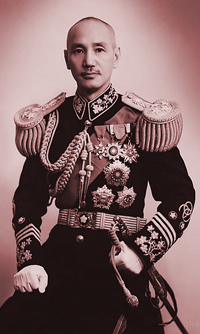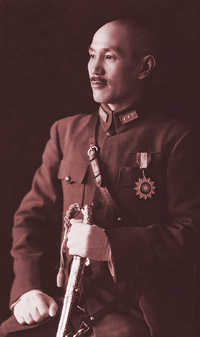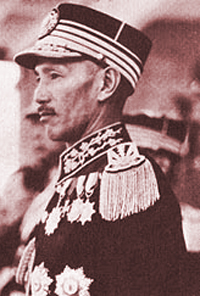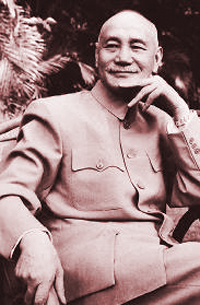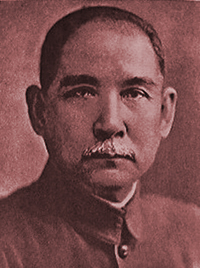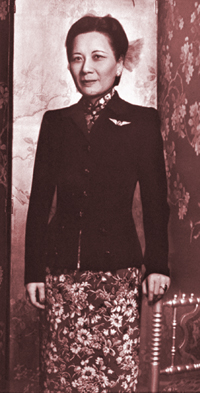
5 YUAN COIN - TAIWAN - CHIANG KAI-SHEK
(Y 548)
Date: A.D. 1972
Obverse: Portrait facing left - REPUBLIC OF CHINA - YEAR 61
Reverse: Border with denomination - FIVE YUAN
Sun Yat-sen
Soong May-ling (Madame Chiang Kai-shek) |
This coin depicts the Chinese Nationalist leader Chiang Kai-shek. Chiang Kai-shek was born in the town of Xikou in Fenghua county, Zhejiang Province, China, on October 31, 1887. Chiang's father was a local wine merchant who died when he was very young. His family arranged for him to be married to a fellow villager, Mao Fumei, with whom he had two children, a son Ching-Kuo and a daughter Chien-hua. He joined the provincial military and spent a year in a Chinese military academy. By all accounts a good soldier, Chiang traveled to Tokyo in 1907 to attend the Japanese Army Military State College in Paoting where he took part in revolutionary activities led by Sun Yat-sen, the leader of the Tongmenghui, what would become the Kuomintang Nationalist party. During the successful Revolution of 1911 which aimed at the overthrow of the Qing Dynasty, Chiang was entrusted with the command of a regiment. Showing his skill as a commander Chiang and his regiment captured Shanghai and Chiang became a founding member of the Kuomintang (KMT). After a successful counter revolution, Chiang returned to exile in Japan for a time traveling back and forth from Japan to safe havens in Shanghai. During this time Chiang developed relations with organized crime and police reports show an arrest warrant for him for armed robbery. In 1912, Chiang shot and killed Tao Chengzhang, the leader of the Restoration Society, at point-blank range as Tao lay sick in a Shanghai hospital. In 1916 Chiang became the leader of the Chinese Revolutionary Party in Shanghai. Power struggles mark this chaotic time but with the help of mercenaries from Yunnan, and aid from the Comintern, Sun Yat-sen emerged unscathed and in control at Guangzhou in early 1924. He quickly began to reform the Kuomintang establishing a revolutionary government aimed at unifying China. During this time Chiang spend three months in Moscow studying the Soviet political and military system. By 1924 the KMT, with help from the Soviet Union, had increased in power and Chiang became Commandant of the Whampoa Military academy set up by Sun near Canton in southern China. This position allowed Chiang to cultivate a loyal inner circle of officers. By 1925, Chiang's was scoring victories against local rivals in Guangdong province. After Sun Yat-sen's death in 1925, a brief power struggle with rival Wang Ching-wei ensued. Chiang emerged from the fray as the Commander-in-Chief of the National Revolutionary Forces. He wasted no time in launching the Northern Expedition, a military campaign to defeat the warlords controlling northern China in an attempt to unify the country under the Kuomintang. Leftists led by Wang Jing-wei, with the aid of the Soviets and communist allies, took the city of Wuhan and declared the National Government to now be based in Wuhan. On April 12, Chiang began a swift and brutal attack on thousands of suspected Communists. He then established his own National Government in Nanking supported by conservative allies. The communists were purged from the KMT and the Soviet advisers were expelled. This earned Chiang the support and financial backing of the Shanghai business community. Wang Jing-wei's National Government, though popular, was weak militarily and was soon overtaken by a local warlord. the warlord Zhang Xueliang eventually pledged allegiance to Chiang's government. In 1927 he married Soong May-ling (later to be known a Madame Chiang Kai-shek) whom he had met in 1920. She was the sister-in-law of Sun Yat-sen and the daughter of a prominent and powerful Shanghai publishing tycoon. This would position him as Sun Yat-sen's brother-in-law but May-ling's mother vehemently opposed the marriage. Not only was he already married to Mao Fumei, but he was a Buddhist (Soong May-ling was a Christian). She agreed to the marriage only after Chiang showed proof of his divorce and promised to convert to Christianity. Chiang told his future mother-in-law that he could not convert immediately, because religion needed to be gradually absorbed, not swallowed like a pill. He was baptized in the a Methodist church in 1929. Chiang achieved an unsteady national unity In 1928 and was named Generalissimo of all Chinese forces and Chairman of the National Government based in Nanjing. Following Sun Yat-sen's three step plan, the new Chinese state would first be held under military rule, then political tutelage, and finally constitutional rule, with the ultimate goal being democratic rule. The first step was complete but democratic rule in a fractured Chinese state was not possible. Chiang's rule began the period of political tutelage, under the dictatorship of the Kuomintang, to prepare China for constitutional democracy. During this period, Chiang took steps to transform China into a modern nation. In the following decade Chiang's government worked to modernize the legal and penal systems, institute Major financial reforms, Improve the educational system, build new highways and railroads, improve public health facilities, legislate against drug trafficking, and augment industrial and agricultural production. Chiang also established the New Life Movement in 1934 which reasserted traditional Confucian values to combat communist ideas. Still he was unable to crush the popular communist movement. Though his government was in control of most urban areas, communism was popular in rural areas and during this time he was constantly forced to battle communist uprisings in various areas which cost his government dearly in money and lives. In Chiang's fifth campaign to defeat the Communists in 1934, he surrounded the Red Army only to see the Communists escape through the epic Long March to Yan'an. After Japan's invasion of Manchuria in 1931, Chiang resigned as Chairman of the National Government. He returned shortly after adopting a slogan "first internal pacification, then external resistance", which meant that the government would first attempt to defeat the Communists before engaging the Japanese directly. During an offensive against communist forces at Yan'an, Chiang was kidnapped and essentially forced to enter into an uneasy truce with communist forces to present a unified front against the Japanese invaders thus temporarily ending the long ongoing civil war. Chiang was now at the head of a unified front (militarily if not politically) but he lost control of most of the coastal regions and most of the major cities fell before a rapidly advancing Japanese offensive. Chiang had worked to expand and modernize his armed forces, build fortifications and communication lines around the country, and develop a viable military industry capable of supporting a strong resistance but could no longer put off the inevitable. He sent 500,000 of his best trained soldiers to defend Shanghai. With about 200,000 Chinese casualties, Shanghai fell and by December the capital city of Nanjing had also fallen to the Japanese and Chiang was forced to moved his government inland to Chongqing. His forces were no longer able to launch an effective offensive and instead concentrated on defending what territory they still held. Eventually China became one of the Allied Powers. After the bombing of Pearl Harbor, Chiang and his government received considerable financial support from the United States. General Joseph Stilwell disagreed with this policy and asserted that Chiang was actively looking to boost his power base in preparation for the end of the war when he would launch his final purge of communist forces from China. Stilwell was recalled to the United States and was replaced by General Albert Wedemeyer. The U.S. regarded Chiang as an important ally who was able to help shorten the war by engaging the Japanese occupiers in China. Chiang was, in fact, looking to build up his army for certain conflict with the communist forces after the end of World War II. After the war, and despite his efforts, Chiang's government was weakened while the motivated communist forces lead by Mao Zedong were strong. A mad rush to control China erupted into all out civil war. Having lost much of his US aid, Chiang government was deteriorating and suffering from corruption within the ranks. Severely weakened both in terms of resources and popularity, the Nationalists who initially had superiority in arms and men lacked popular support resulting in poor morale and apparent disorganization. This soon allowed the Communists, strengthened by aid from Stalin and guerrilla organizations, to gain the upper hand and KMT forces suffered massive losses. During the Struggle of the Chinese Civil War more than 8 million soldiers and civilians would perish in a span of roughly 20 years of intermitant but steady conflict between the Republic of China (ROC) Nationalists and Communists forces. close to two milion people died in the conflict between 1948 and 1949 alone. The communists gradually gained control of the country and on October 1, 1949, Mao Zedong announced the establishment of People's Republic of China (PRC). On December 10, 1949, Communist troops laid siege to Chengdu, the last KMT occupied city in mainland China, where Chiang Kai-shek and his son Chiang Ching-kuo directed the defense at the Chengdu Central Military Academy. After years of civil war, Chiang and the nationalists were forced to flee to the island of Taiwan. Chiang moved his government to Taipei where he continued as the President of the Republic of China in exile. He continued to claim sovereignty over all of China. In the context of the Cold War, most of the western world recognized this position and his government in exile represented China in the United Nations and other international organizations until the early 1970s. The US was a strong ally to Taiwan providing military protection from invasion by the mainland. The US provided logistical support as well as support militarily and monetarily. The island and its inhabitants were highly dependant on US support who continued to recognize them as the true government of China and saw them as a better alternative to "Red" China. Despite the democratic constitution, there was criticism of the government under Chiang as being authoritarian and corrupt as it operated under constant emergency provisions giving Chiang's government sweeping, almost dictatorial powers under martial law. These provisions stemmed from the claim that the Communists and KMT were still technically under a state of war, without any cease-fire signed. Since new elections could not be held in Communist-occupied mainland china, the National Assembly, Legislative Yuan, and Control Yuan members held their posts indefinitely. It was also under these so-called Temporary Provisions that Chiang was able to bypass term limits to remain as president. He was reelected by the National Assembly as president four times - in 1954, 1960, 1966, and 1972. In 1975, shortly after suffering a major heart attack and a bout of pneumonia, Chiang Kai-shek died at the age if 87, in his 26th year of exile, in Taipei Taiwan. Chiang was succeeded as President by Vice President Yen Chia-kan and as KMT party leader by his son Chiang Ching-kuo who retired Chiang Kai-shek's title of Director-General and instead assumed the position of Chairman. For some, Chiang was a champion of anti-communism and seen as a great leader who fought for a free China against the japanese and communist rebels. To others, Chiang is remembered as a military dictator who abused his political power through his party's dominance over the media and government. Some in Taiwan believe he was less concerned about the welfare of the nation and more concerned with retaking the mainland and that his efforts in reconstructing Taiwan was to make the island a strong base for an invasion of China. Still, he is credited for taking the fist step to modernizing China and under his presidency Taiwan flourished. With the death of his son in 1988, an end to martial law, and sweeping reforms marked by a move to democracy, the dominance of the KMT began to wane as did the legacy of Chiang Kai-shek. The KMT lost power for the first time in 2000, after three decades of rule, with its loss in free elections to Chen Shui-bian of the Democratic Progressive Party (DPP). The PRC replaced the ROC as representative of China in the UN in 1971 and due to the refusal of both the ROC and PRC to accept anything but a One-China solution, Taiwan is currently a non-UN aligned state, still claimed by KMT and the PRC who see's it as a rouge state. The US still supports Taiwan in many ways, including in the UN and its attempts to be recognized as a legitmate State once it softed on the possibility of a two-China solution. Although US does not recognize Taiwan as 'The Republic of China', its relationship with Taiwan is now guided by the Taiwan Relations Act that still obliges the US to protect the Island of Taiwan against attack and makes possible economic and miltary support between the US and the island. The US has always been, and remains, a critically important ally to Taiwan. |

